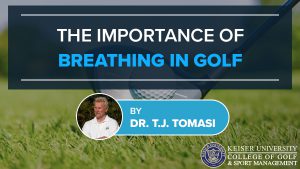The Importance of Breathing in Golf

Keiser University College of Golf Senior Faculty and Director of Research
In an interview on CNN, Hillary Clinton tells about using a stress reducing technique called Alternate Nasal Breathing (ANB) to help her recover from the shock of losing the presidential election.
What is ANB
The role ANB played in her recovery is also outlined in her book “What Happened?” For years I have been teaching my students to be in a “GO” state, with adrenaline flowing and heart rate rising, when they hit a golf shot; then to toggle into a relaxed state between shots. To help them relax, I teach them a breathing technique involving ANB, which they can integrate into their shot routine.
Below, I outline a research project at Keiser University directed by Dr. Eric Wilson and conducted by myself and faculty member John Callahan, that documents how well ANB works. The study was published in a slightly different form in the October 2015 issue of Golf Magazine.
Research Model
The participants were 15 student golfers, ages 19-35; all male and all right-handed, with USGA handicaps between 3 and 18. None of the subjects were familiar with ANB. The testing occurred indoors, where the subjects hit into a net with a target 17 yards away. Swing metrics were recorded using TrackMan radar technology. Pulse rate was logged using a finger-tip Pulse Oximeter model CVS #C20.
Procedure:
Step 1:
After warm up, all participants hit 10 shots with their personal six iron to establish a performance baseline. A pulse reading was recorded standing behind the ball before each shot.
Step 2:
ANB was introduced to each subject using a five to ten minute personalized training session, where they were taught to breathe deeply in the diaphragm, then inflate the chest, then hold for one count and slowly exhale, all while breathing first through the left nostril and then through the right.
The subjects simply held one nostril shut for one breath, then switched nostrils for the other breath, so that one full cycle of ANB was two breaths.
Post Training:
After ANB training, each participant made one full cycle of ANB for each of 10 shots and a pulse reading was taken again for each shot. The metrics of each shot were recorded using TrackMan technology as in Step 1.
Results:
All 15 participants exhibited lower pulse readings after ANB – on average, a significant reduction of 8.5 beats (77.9 was the field’s average before ANB and 69.4 after).
Twelve of 15 had an increase in clubhead speed from Step 1 to Step 2, while 13 showed an increase in ball speed and distance. The average increase in distance for all 15 participants was 5.8 yards.
Interestingly, 13 of the 15 participants produced an increase in Smash Factor (an indication of better Centeredness of Contact), which may have been due to a more relaxed, less manipulated release at impact.
After the trials were completed, the subjects were asked to describe how they felt after using ANB. Below is a summary that fairly represents the feedback:
“Wow! I feel like taking a nap.”
“I feel so relaxed; I can use this intervention for other parts of my life.”
“I’ll have to do this before giving my speech in Speech Class. I feel much less nervous.”
“I feel so calm, I have to do this before my next algebra test.”
“I feel less tension.”
“Am I supposed to feel this loose?”
“I’m swinging more slowly now, aren’t I?” (Actually he was swinging about 6 MPH faster!)
Interpretation:
The average drop in pulse rate (8.5) is significant and, in addition to body relaxation, ANB showed an increase in performance as indicated in the Smash Factor improvement from 1.32 to 1.36 (better center contact).
A Smash Factor of 1.38 is the norm for PGA tour players using a six iron, so this represents a significant increase in an important metric dealing with distance and ball curve – all from a change in breathing!
There is much research across multiple domains that demonstrates a relationship between controlled breathing and quality performance, and our study outlines a simple technique to accomplish this that has been used for 3000+ years in disciplines like yoga and eastern medicine.
Takeaway:
When you’re standing behind the ball visualizing your shot, perform one cycle of ANB then walk to your ball and hit the shot.
If you enjoyed this golf tip, here’s how you can get even more. Contact Keiser University College of Golf about a golf management degree.












